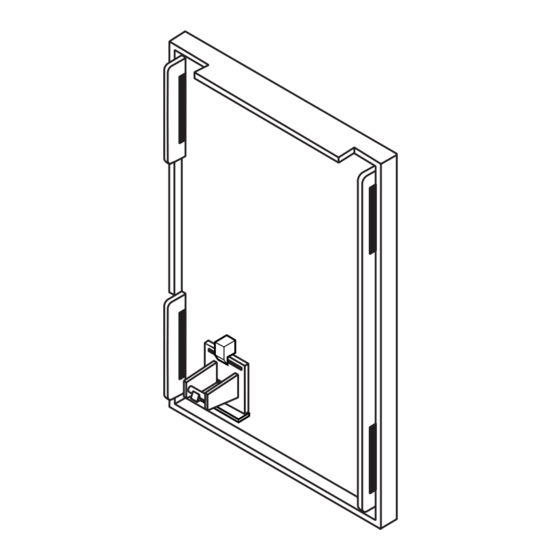Advertisement
GENERAL INFORMATION
This module adds up to eight end-of-line resistor supervised
zones to compatible control/communicators via the control's
keypad wiring.
The module may be mounted within the control's cabinet (if
room permits), or remotely. If mounted remotely, there are
provisions to tamper protect the unit. Communication to
the module is supervised so that it cannot be disconnected
from the keypad wiring without detection by the control. If
the wiring is cut, a tamper alarm or signal will result, to
indicate that this device (and possibly other similarly
connected devices) has become inoperative.
INSTALLATION
1.
Power
before proceeding.
2.
Be sure to mount the 4219 before
making any wire connections.
When the module is mounted remotely, holes on the back of
the module's housing permit it to be mounted horizontally
or vertically. Wires can exit from the side or the breakout
on the back of its housing. For tamper protection, attach
the tamper magnet (provided) (Figure 1) to the module
inside cover. Place the tamper jumper (Figure 2) into its
lower position. Affix the connections label that accompanies
the module to the inside of the module's cover. When the
installation is complete, put the modules cover on.
magnet attached to the cover, positioned near the reed
switch, will cause a tamper signal to be sent to the control if
the cover is removed.
When the module is to be mounted inside the control's
cabinet, mount it horizontally to the raised tabs at the back
of the cabinet. Insert self-tapping screws (provided) in two
adjacent raised tabs at the back of the cabinet. Leave the
heads projecting 1/8". Hang the module on the screw heads
via two slotted holes on the back of the module's housing.
When the module is installed in the control's cabinet, it
need not be tamper protected. Place the tamper jumper
(Figure 2) in the upper position. Affix the connections label
that accompanies the module to the inside of the control's
cover.
ee the control's installation and setup guide for additional
S
information.
CONNECTIONS AND SETTINGS
Make protection zone connections to the module's 12-
position terminal block TB1. Each zone that is used must
have a 1000-ohm end-of-line resistor connected across the
end of its loop, as shown in Figure 1.
For CE installations ADEMCO N6361
EMI suppression bead is
C E
Refer to the N6361 installation guide for
wire routing instructions.
INSTALLATION AND SETUP GUIDE
should
be
disconnected
required.
Wired Zone Expander Module
Figure 1. Tamper Magnet Installation
If a zone is not programmed, the resistor need not be used.
The
The method of programming each zone for the type of alarm
and reporting code to the central monitoring station varies
with the control to which the module is connected. Refer to
the Installation and Setup Guide for that control unit.
Set the DIP Switch to one of 16 addresses, as shown in
Figure 3, so the control can identify the module and
communicate with it properly.
determined by the particular control to be used, and the
control's installation instructions must be consulted.
shipped, the DIP Switch is set for an address of "0".
Zone A can be set for fast response time of 10ms to an open
circuit, if desired, by setting position 1 of the DIP Switch to
"OFF". As shipped, it is set to "ON" for a response time of
300ms, as shown in the table below. All of the module's
other protection zones have a nominal response time of
300ms.
Connections to the control's keypad wiring points can be
made via 4-terminal block TB2 or the 4-pin plug (wire color
connections are the same).
SPECIFICATIONS
Physical
Electrical
Input Voltage:
Current:
N8924V1 5/01 Rev. B
1. INSERT BOTTOM TABS FIRST.
2. ENGAGE TOP WITH CLIP.
The address to be set is
6-7/16"W x 4-1/4"H x 1-1/4" D
(163mm x 108mm x 32mm)
12VDC
(from
control's
keypad connection points)
30mA
4219
4219-002-V0
As
remote
Advertisement

Summary of Contents for Honeywell 4219 - Ademco 8 Zone Expander
- Page 1 N8924V1 5/01 Rev. B 4219 Wired Zone Expander Module INSTALLATION AND SETUP GUIDE GENERAL INFORMATION This module adds up to eight end-of-line resistor supervised zones to compatible control/communicators via the control’s keypad wiring. The module may be mounted within the control’s cabinet (if room permits), or remotely.
-
Page 2: Summary Of Connections
NOTE FOR CE INSTALLATIONS A 4219 DIP SWITCH N6361EMI SUPPRESSION FOR SETTING ADDRESS BEAD IS REQUIRED. AND ZONE A RESPONSE REED (TAMPER) SWITCH TAMPER JUMPER POSITION 4219 IN CABINET DATA OUT (NOT TAMPER) TO CONTROL 4-PIN CONSOLE PLUG 4219 REMOTE (–) GROUND CONNECTIONS SAME (TAMPER PROTECTED) - Page 3 LIMITED WARRANTY Honeywell International Inc., 165 Eileen Way, Syosset, New York 11791, warrants its product(s) to be in conformance with its own plans and specifications and to be free from defects in materials and workmanship under normal use and service for 24 months from the date stamp control on the product(s) or, for product(s) not having a date stamp, for 12 months from date of original purchase unless the installation instructions or catalog sets forth a shorter period, in which case the shorter period shall apply.
- Page 4 The user shall not make any changes or modifications to the equipment unless authorized by the Installation Instructions or User’s Manual. Unauthorized changes or modifications could void the user’s authority to operate the equipment. 165 Eileen Way, Syosset, NY 11791 Copyright 2004 Honeywell International Inc. www.honeywell.com/security N8924V1 5/01 Rev. B...











Need help?
Do you have a question about the 4219 - Ademco 8 Zone Expander and is the answer not in the manual?
Questions and answers